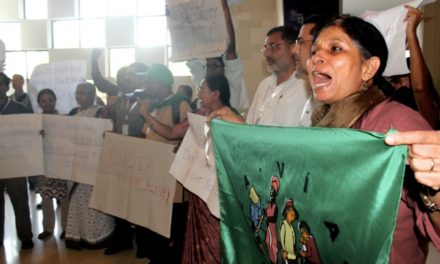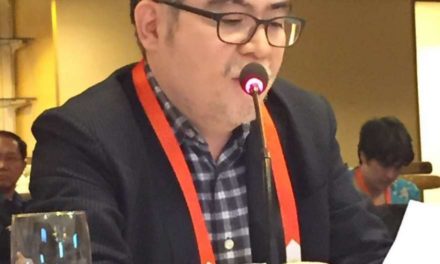Aileen Kwa,Geneva
The US and EU have stubbornly opposed opening the Green Box. No real discussion has taken place in terms of examining this nature and impact. They have merely insisted that it is non-trade distorting, and therefore beyond reach in this Round, and that the “review and clarification process” is not about making changes to the nature of the box.
Agriculture Chair, Crawford Falconer is clearly playing to their tune in his second installment (25 May) text. Apart from tweaking a couple of provisions to make clear that certain developing countries programmes are also covered in the box (no real gift since it would have been inferred that these programmes are covered anyway), he simply concludes that “Beyond that, I have the impression that there is strong reluctance to entertain much more by way of amendments to Annex 2. Of course a number of Members would prefer things otherwise, but I doubt that view will prevail.” And with his silence, he attempts to wipe out many issues the G20 has raised for years, on methods to discipline the Green Box.
He also avoids confronting the fact that US and EU are shifting blue and amber supports into green in order to cope with their reduction commitments in those boxes. Green Box payments allow these countries to have lower intervention prices. Yet farmers are compensated through direct payments, and they continue production (cereal production is increasing in the EU despite ‘decoupling’). The bulk of these payments have been found to be as trade distorting, if not more so, for being so nontransparent.
The one area where Falconer makes a weak attempt at seeming to take on board a major G20 concern is in the issue of fixed and unchanging base periods. The issue here is that farmers continue to stay in production since they know (in the US and EU) that a CAP reform or new farm bill takes place every few years, and base periods are revised with each new reform or bill. Keen to guarantee incomes in the future, producers thus remain in production.
The Chair’s comments on this issue in para 27 seem rather unclear. He says “The concept is clearly to draft in a way that provides for occasional changes in base periods provided these are not done in a way that implied a link to prices or production.” Is this not exactly the problematic situation now? Each Farm Bill or CAP reform is an ‘occasional change’. US and EU say that their current system is not linked the prices and production. What does Falconer mean and upon what basis will governments use to calculate payments to producers, if not by basing payments on production, income/ revenue, or prices?
The major requests by the G20 which have not been taken up include: i) that direct payments should be directed only at low levels of income, landholding and production – this is the one way to ‘cap’ the Green Box; ii) that direct payments should not be made in conjunction with AMS supports or Blue Box supports. This interlinkage of policies often ensures that producers continue production in order to obtain maximum income.
Litigation
The reasons why the Green Box has to be strictly disciplined, narrowed down and preferably even capped, are already clearly provided in the WTO’s own litigation.
In the cotton case, the Panel ruled that US green box payments did not belong there because they were tied to production conditionalities (producers were not allowed to plant fruit, vegetables and wild rice), leading to production distortions.
Posing an even greater challenge to the fundamental character of the Green Box, the Appellate Body in the Dairy Products of Canada case, in its 3 December 2001 report stated that
“We consider that the distinction between the domestic support and export subsidies disciplines in the Agreement on Agriculture would also be eroded if a WTO Members were entitled to use domestic support, without limit, to provide support for exports of agricultural products. Broadly stated, domestic support provisions of that Agreement, coupled with high levels of tariff protection, allow extensive support to producers, as compared with the limitations imposed through the export subsidies disciplines. Consequently, if domestic support could be used, without limit, to provide support for exports, it would undermine the benefits intended to accrue through a WTO Member’s export subsidy commitments (para 91)… The potential for WTO Members to export their agricultural production is preserved, provided that any export-destined sales by a producer at below the total cost of production are not financed by virtue of governmental action (para 92)”. 1
Studies Show the Green Box is Distorting
Recent research by UNCTAD – India shows that the current Green Box subsidy programmes used by some developed WTO Members are not in keeping with the “no or at most minimal, trade-distorting effects or effects on production” criteria.
According to the study, if the trade-distorting elements of the Green Box were removed, the cost of production in key economies would increase by 15-30% and their exports would decline by 40-60%. Developing countries would see an increase in exports by about 20%. Even LDCs will find their exports going up by 20%. Global imports would also decline. Agricultural employment will rise in almost all developing countries. This rise in employment of skilled and unskilled labour would lead to the alleviation of poverty. The rise in employment in developing countries is estimated to range between 3-5%, far higher than the rate of natural increase of the labour force. Wages would also rise by 1% on average in developing countries, with LDCs registering the highest increase. Hence there are significant and positive poverty attenuating effects as a result of reducing Green Box subsidies. 2
A World Bank study also concluded that decoupling of farm payments is only effective if properly managed. They should be a one-time buyout programme to compensate farmers for the transition. If they are not one-time payments, there should be a time-limit, harmonization with other support programmes, as well as constraints on input use in order for it to be effective as a transitional adjustment assistance. “Unless these aspects are properly addressed, decoupled programs are likely to have the same detrimental effects as other subsidy programs”.3
Case of the EU – Decoupled And Distorting
The EU is now shifting most of its amber and blue subsidies into the Green Box – in what is called the ‘Single Payment Scheme” (SPS). Up to 30 billion Euros is now being provided by the EU in this scheme, housed in the Green box. EU Trade Commissioner Mandelson has said that up to 90% of EU agricultural supports will soon be in this form. The SPS is supposedly decoupled and hence, the argument is made that it is not or only minimally trade distorting.
Is this in fact the case? EU decoupling in the past has been shown to be as trade distorting as production related payments. Since the 1990s, the EC has been decoupling part of its subsidies on cereals. EC intervened at prices much closer to the world price, and 50 percent lower than the previous intervention price, whilst channeling payments to farmers directly. If the theory of decoupling were right, cereal production should have fallen, since farmers could have produced less. On the contrary, the EU cereals production increased by 25 percent in the 1990s, instead of contracting because overall subsidy levels had in fact increased. The direct payments given had been calculated to more than adequately make up for losses experienced as a result of a lower intervention price.
How the Green box is Trade Distorting
These following factors have been found to contribute to trade distortions in the Green Box:
-
Size of Subsidies and Wealth Effects
In their last notification, some Members use of the Green Box ranged from about 9 – 15% of their value of production. This percentage is increasing significantly as certain members are shifting the majority of their farm supports towards decoupled payments.
In theory, decoupled payments are provided to farmers irrespective of their production decisions and are therefore claimed to be non-trade distorting. In practice, farmers make production decisions based on the total income they anticipate – from direct payments as well as income expected from production. When these amounts are significant, they keep farmers in production even though domestic prices are often lower than the costs of production. As such, they are indirectly a form of price supports.
Large payments can have risk reduction effects that lead to increased output. They increase base income, and help cover fixed costs allowing farmers to cross-subsidize production at market prices. Direct payments can affect farmers’ investment and exit decisions if they are facing constraints in capital and labour markets. They improve farmers’ credit worthiness, allowing banks to make loans when they otherwise may not. 4
-
General Services, Environmental Services and Wealth Effects
It has also been found that even general services and environmental services (components in the Green Box usually seen as non-trade distorting), through their sheer quantity, reduce the cost of production by 11% and 16% respectively. The exact magnitude differs across crops. 5 -
Updating and Expectations About Future Policies
Direct or decoupled payments are often provided on the basis of a historical period. However, the reference years used are being updated. As a result, farmers are not in reality making decisions independent of production. Many continue to produce in order to ensure that when the historical period is updated, their payments will be assured. -
Planting Restrictions
Payments are not delinked from production when there are planting restrictions. With restrictions, farmers are more likely to continue producing what they used to produce. The trade distorting effect of such restrictions have been established in the cotton panel. -
Co-existence of Coupled and Decoupled Payments Enhances Incentives to Overproduce
Several members have chosen to mix decoupled payments with coupled payments. As a result of the way the programmes interact, there is an incentive for production and no real delinkage between payments and production. For example, farmers may receive only 50% of payments if they do not produce (50% of payments are coupled), but receive 100% of payments if they do produce. This makes it highly likely that farmers continue production.
Comments on the Chair’s Recommendations: Guide to Changes Required in Annex 2 (Green Box)
[Additions to Annex 2 are in bold, deletions from the original text are struck out, author’s comments explaining reasons for changes are in brackets and are italicised.]
1. Domestic support measures for which exemption from the reduction commitments is claimed shall meet the fundamental requirement that they have no, or at most minimal, trade-distorting effects or effects on production for developed countries. Accordingly, all measures for which exemption is claimed by developed countries shall conform to the following basic criteria:
(a) the support in question shall be provided through a publicly-funded government programme (including government revenue foregone) not involving transfers from consumers; and,
(b) the support in question shall not have the effect of providing price support to producers;
[It seems patently unfair that developing countries, whose agricultural sectors remain extremely underdeveloped should be subject to these disciplines when the developed countries which have had decades of unlimited domestic supports are not even abiding by these disciplines]
plus policy-specific criteria and conditions as set out below.
Government Service Programmes
2. General services
Policies in this category involve expenditures (or revenue foregone) in relation to programmes which provide services or benefits to agriculture or the rural community. They shall not involve direct payments to producers or processors. In developed countries, these supports provided to the communities or the agriculture sector shall be determined by clearly-defined criteria of low levels of income, landholding or production levels. Such programmes, which include but are not restricted to the following list, shall meet the general criteria in paragraph 1 above and policy-specific conditions where set out below:
[This recommendation is in keeping with UNCTAD’s analysis that general services, due to their quantity, reduces production costs by up to 11-16%]
(a) research, including general research, research in connection with environmental programmes, and research programmes relating to particular products;
(b) pest and disease control, including general and product-specific pest and disease control measures, such as early-warning systems, quarantine and eradication;
(c) training services, including both general and specialist training facilities;
(d) extension and advisory services, including the provision of means to facilitate the transfer of information and the results of research to producers and consumers;
(e) inspection services, including general inspection services and the inspection of particular products for health, safety, grading or standardization purposes;
(f) marketing and promotion services, including market information, advice and promotion relating to particular products but excluding expenditure for unspecified purposes that could be used by sellers to reduce their selling price or confer a direct economic benefit to purchasers; and
(g) infrastructural services, including: electricity reticulation, roads and other means of transport, market and port facilities, water supply facilities, dams and drainage schemes, and infrastructural works associated with environmental programmes. In all cases the expenditure shall be directed to the provision or construction of capital works only, and shall exclude the subsidized provision of on-farm facilities other than for the reticulation of generally available public utilities. It shall not include subsidies to inputs or operating costs, or preferential user charges.
(h) policies and services related to agrarian, land and institutional reform and the redress of historical land ownership structures, and any other programmes related to food and livelihood security and rural development in developing country Members, including services related to such reform and other programmes. These include inter alia, settlement programmes, issuance of property titles, employment assurance, provision of infrastructure, nutritional security, poverty alleviation, soil conservation and resource management, and drought management and flood control.
[This addition brings together all the elements contained in both the African Group and G20 proposals]
3. Public stockholding for food security purposes 5
Expenditures (or revenue foregone) in relation to the accumulation and holding of stocks of products which form an integral part of a food security programme identified in national legislation. This may include government aid to private storage of products as part of such a programme.
The volume and accumulation of such stocks shall correspond to predetermined targets related solely to food security. The process of stock accumulation and disposal shall be financially transparent. Food purchases by the government shall be made at current market prices and sales from food security stocks shall be made at no less than the current domestic market price for the product and quality in question.
5For the purposes of paragraph 3 of this Annex, governmental stockholding programmes for food security purposes in developing countries whose operation is transparent and conducted in accordance with officially published objective criteria or guidelines shall be considered to be in conformity with the provisions of this paragraph, including programmes under which stocks of foodstuffs for food security purposes are acquired and released at administered prices, provided that the difference between the acquisition price and the external reference price is accounted for in the AMS.
[This is the exact language of the African Group proposal]
4. Domestic food aid6
Expenditures (or revenue foregone) in relation to the provision of domestic food aid to sections of the population in need.
Eligibility to receive the food aid shall be subject to clearly-defined criteria related to nutritional objectives. Such aid shall be in the form of direct provision of food to those concerned or the provision of means to allow eligible recipients to buy food either at market or at subsidized prices. Food purchases by the government shall be made at current market prices and the financing and administration of the aid shall be transparent.
5 & 6For the purposes of paragraphs 3 and 4 of this Annex, the provision of foodstuffs at subsidized prices with
the objective of meeting food requirements of urban and rural poor in developing countries on a regular basis
at reasonable prices shall be considered to be in conformity with the provisions of this paragraph.
5. Direct payments to producers
Support provided through direct payments (or revenue foregone, including payments in kind) to producers for which exemption from reduction commitments is claimed shall meet the basic criteria set out in paragraph 1 above, plus specific criteria applying to individual types of direct payment as set out in paragraphs 6 through 13 below. Direct payments shall not be linked to production levels, including input levels therein. When Members make such payments, they shall notify the base period and all other relevant criteria, as well as the laws, regulations and administrative decisions of such programmes made under this provision. Further notifications under paragraph 5(a) shall include regular and periodic information on how the programmes under this provision achieve the stated objectives.
Where exemption from reduction is claimed for any existing or new type of direct payment other
than those specified in paragraphs 6 through 13, it shall conform to criteria (b) through (e) in paragraph 6, in addition to the general criteria set out in paragraph 1.
[This is taken from the G20 proposal]
6. Decoupled income support
(a) For developed countries, eligibility for such payments shall be determined by clearly-defined criteria such as of low levels of income, status as a producer or landowner, landholding and production level in a notified, defined and fixed and unchanging base period. Developing country Members who have not previously made use of decoupled payments, shall be permitted to do so.
[This is a critical discipline – there is a need, if not to cap such payments, then in the least to limit them to low income producers. This suggestion is ignored by the Chair. The first sentence comes from the G20 language in order to prevent box shifting.
However, the G20 proposal also advocates binding developing countries’ to a base period. See below. This is problematic. It is also problematic that the Chair has jumped on and accepted this part of the proposal (see para 26 of the Chair’s text). Many developing countries’ agricultural sectors are way below potential. To bind ourselves to a base period when the sector is dynamically developing is not likely to be helpful.
The G20 language says:
Developing country Members who have not previously made use of this type of payment, and thus have not notified, shall not be precluded from establishing an appropriate base period7, which shall be fixed and unchanging and shall be notified.
7 Developing country Members may not have the capacity to fully assess the impact of innovation in their agricultural policies. Accordingly, the base period of a time-limited experimental or pilot programme may not be taken as the fixed and unchanging base period for the purposes of this paragraph.]
(b) The amount of such payments in any given year shall not be related to, or based on, the type or volume of production (including livestock units) undertaken by the producer in any year after the base period.
(c) The amount of such payments in any given year shall not be related to, or based on, the prices, domestic or international, applying to any production undertaken in any year after the base period.
(d) The amount of such payments in any given year shall not be related to, or based on, the factors of production employed in any year after the base period.
(e) Land, labour, or any other factor of production shall not be required to be in ‘agricultural use’ and no production shall be required in order to receive such payments.
[Language from G20 proposal to tighten decoupling]
(f) Such payments shall not be made in conjunction with AMS support and support under Article 6.5, if the sum of such support, as appropriate8, exceeds X per cent of the annual value of production of a given product.
8 This is without prejudice to the final outcome of the negotiations of the amendment of Article 6.5.
[Also from the G20 proposal, and again, ignored by the Chair. This is an important addition. It is to prevent ‘false’ decoupling eg. The EU CAP allows for 75% decoupled payments and 25% coupled payments. The mix of policies have the effect of providing an incentive for producers to continue being in production.]
7. Government financial participation in income insurance and income safety net programmes
(a)Eligibility for such payments shall be determined by an income loss, taking into account only income derived from agriculture, which exceeds 30 per cent of average gross income or the equivalent in net income terms (excluding any payments from the same or similar schemes) in the preceding three-year period or a three-year average based on the preceding five-year period, excluding the highest and the lowest entry, or in the case of a developing country Member, income loss can be less than 30 per cent. Any producer meeting this condition shall be eligible to receive the payments.
[This has been more or less accepted by the Chair (para 26). The G20 language is slightly more constraining. It recommends:
or in the case of a developing country, payments will be made ‘in accordance with specific criteria which shall be defined in national legislation9
9Includes administrative orders and regulations made by the designated competent authorities. ]
(b) The amount of such payments shall compensate only up to for less than 70 per cent of the producer’s income loss in the year the producer becomes eligible to receive this assistance. In the case of a developing country Member, compensation can be more than 70 per cent of the producer’s income.
[G20 proposal:
In the case of a developing country Member, compensation shall only be up to a certain proportion of the producer’s income which shall be defined in national legislation10.
10Includes administrative orders and regulations made by the designated competent authorities. ]
(c) The amount of any such payments shall relate solely to income; it shall not relate to the type or volume of production (including livestock units) undertaken by the producer; or to the prices, domestic or international, applying to such production; or to the factors of production employed.
(d) Where a producer receives in the same year payments under this paragraph and under paragraph 8 (relief from natural disasters), the total of such payments shall be less than 100 per cent of the producer’s total loss.
8. Payments (made either directly or by way of government financial participation in crop insurance schemes) for relief from natural disasters
(a)Eligibility for such payments shall arise only following a formal recognition by government authorities that a natural or like disaster (including disease outbreaks, pest infestations, nuclear accidents, and war on the territory of the Member concerned) has occurred or is occurring; and shall be determined by a production loss which exceeds 30 per cent of the average of production in the preceding three-year period or a three-year average based on the preceding five-year period, excluding the highest and the lowest entry, In the case of developing country Members, payments for relief from natural disasters may be provided to producers when the estimated production loss is less than 30 percent of the average of production in the preceding three-year period or a three-year average based on the preceding five-year period.
[This is from the African Group proposal. The G20 proposal states that payments for developing country Members shall be in accordance to defined national legislation (including administrative orders)]
(b) Payments made following a disaster shall be applied only in respect of losses of income, crop, livestock (including payments in connection with the veterinary treatment of animals), land or other production factors due to the natural disaster or other disaster in question.
[G20 suggestions]
(c) Payments shall compensate for not more than the total cost of replacing such losses and shall not require or specify the type or quantity of future production.
(d) Payments made during a disaster shall not exceed the level required to prevent or alleviate further loss as defined in criterion (b) above.
(e) Where a producer receives in the same year payments under this paragraph and under paragraph 7 (income insurance and income safety-net programmes), the total of such payments shall be less than 100 per cent of the producer’s total loss.
9. Structural adjustment assistance provided through producer retirement programmes
(a) Eligibility for such payments shall be determined by reference to clearly defined criteria in programmes designed to facilitate the retirement of persons engaged in marketable agricultural production, or their movement to nonagricultural activities.
(b) Payments shall be conditional upon the total and permanent retirement of the recipients from marketable agricultural production.
10. Structural adjustment assistance provided through resource retirement programmes
(a) Eligibility for such payments shall be determined by reference to clearly defined criteria in programmes designed to remove land or other resources, including livestock, from marketable agricultural production.
(b) Payments shall be conditional upon the retirement of land from marketable agricultural production for a minimum of three years, and in the case of livestock on its slaughter or definitive permanent disposal.
(c) Payments shall not require or specify any alternative use for such land or other resources which involves the production of marketable agricultural products.
(d) Payments shall not be related to either the type or quantity of production or to the prices, domestic or international, applying to production undertaken using the land or other resources remaining in production.
11. Structural adjustment assistance provided through investment aids
(a) Eligibility for such payments shall be determined by reference to clearly defined criteria in government programmes designed to assist the financial or physical restructuring of a producer’s operations in response to objectively demonstrated structural disadvantages. Eligibility for such programmes may also be based on a clearly-defined government programme for the reprivatization of agricultural land.
(b) The amount of such payments in any given year shall not be related to, or based on, the type or volume of production (including livestock units) undertaken by the producer in any year after a fixed and unchanging the base period other than as provided for under criterion (e) below. Developing country Members shall be precluded from establishing a fixed and unchanging base period.
(c) The amount of such payments in any given year shall not be related to, or based on, the prices, domestic or international, applying to any production undertaken in any year after the base period.
d) The payments shall be given only for the period of time necessary for the realization of the investment in respect of which they are provided.
(e) The payments shall not mandate or in any way designate the agricultural products to be produced by the recipients except to require them not to produce a particular product.
(f) The payments shall be limited to the amount required to compensate for the structural disadvantage.
12. Payments under environmental programmes
(a) Eligibility for such payments shall be determined as part of a clearly-defined government environmental or conservation programme and be dependent on the fulfilment of specific conditions under the government programme, including conditions related to production methods or inputs.
(b) The amount of payment shall be limited to the extra costs or loss of income involved in complying with the government programme.
(c) The conditions spelt out in paragraphs 12 (a) and (b) above shall not apply to payments made by developing countries.
[This is taken from the African Group proposal.]
13. Payments under regional assistance programmes
(a) Eligibility for such payments shall be limited to producers in disadvantaged regions. Each such region must be a clearly designated contiguous geographical area with a definable economic and administrative identity, considered as disadvantaged on the basis of neutral and objective criteria clearly spelt out in law or regulation and indicating that the region’s difficulties arise out of more than temporary circumstances. Developing country Members shall be exempted from the condition that disadvantaged regions must constitute a clearly designated contiguous geographical area with a definable economic and administrative identify.
[The above is both the G20 and African Group language]
(b) The amount of such payments in any given year shall not be related to, or based on, the type or volume of production (including livestock units) undertaken by the producer in any year after the fixed and unchanging base period, which shall be notified, other than to reduce that production. Developing countries should not be precluded from utilizing this kind of payments in the future in the event that no base period was notified.
[The above is from the African Group / G20 proposals. The following has been removed from the African Group proposal:
“An appropriate base period which shall be fixed and unchanging shall be established and notified.”
The G20 proposal, which was more flexible, stated in the footnote that the base period for developing countries ‘of a time-limited experimental or pilot programme may not be taken as the fixed and unchanging base period for the purposes of this paragraph’]
(c) The amount of such payments in any given year shall not be related to, or based on, the prices, domestic or international, applying to any production undertaken in any year after the base period.
(d) Payments shall be available only to producers in eligible regions, but generally available to all producers within such regions.
(e) Where related to production factors, payments shall be made at a degressive rate above a threshold level of the factor concerned.
(f) The payments shall be limited to the extra costs or loss of income involved in undertaking agricultural production in the prescribed area.
1 Cited in Berthelot J 2007 “Communication from the Chairman of the Committee on Agriculture, Special Session, Comments by Jacques Berthelot”, 30 April 2007, http://solidarite.asso.fr
2 UNCTAD India Team 2006 “Green Box Subsidies: A Theoretical and Empirical Assessment”.
3 Baffes, J and Gorter, H 2005 “Experiences with Decoupling Agricultural Support”, in Global Agricultural Trade and Developing Countries, edited by Aksoy A and Beghin J, World Bank, Washington.
4 Baffes, J and Gorter H 2005 ibid.
5 UNCTAD 2006 ibid.









